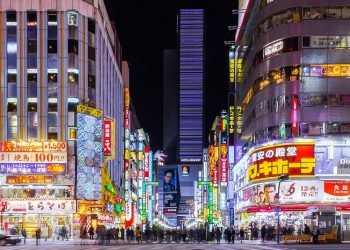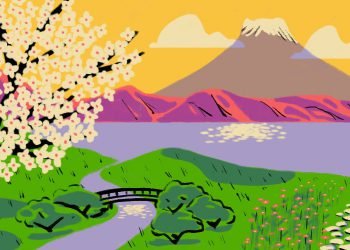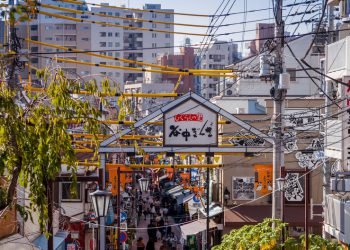The main attraction in Asakusa, Tokyo, is Sensōji Temple | © Horizon Images/Motion / Alamy Stock Photo
Tokyo is an enticing place, and with so much to see and do, planning a short 48-hour stay can be a challenge.
From the moment you master the sprawling train network that governs this city, the vast metropolis of Tokyo starts to unfurl before you. A dream holiday destination for most, Japan’s bustling capital doesn’t disappoint. Here, the truly vintage melds seamlessly with the future and convenience is made an art form. It’s a city where you’ll find ancient shrines just moments away from drip coffee stores and boutiques.
Day one
Morning: Explore Asakusa and Roppongi
For many tourists, the historic sites are the ones with the greatest appeal – these are often beautiful old buildings of architecture that we don’t get to see in our everyday lives. For Tokyo, this place is Asakusa.
The area’s most famous attraction is Sensōji, a 1,400-year-old Buddhist temple. Walking around and taking in the atmosphere can last for hours, and vendors also offer delicious local snacks, the best being wasabi peas. There are also excellent local restaurants and souvenir stores in the surrounding areas (including a place that exclusively sells a range of melon pans).
Visitors at Senso-ji Buddhist temple in Asakusa, Tokyo © Boaz Rottem / Alamy Stock Photo
Just 20 minutes south of Asakusa on the Toei Subway line, Roppongi is the most central district of Tokyo, a total opposite to ancient Asakusa. Its skyscrapers gleam and glisten, and its fancy restaurants spoil travellers for choice. The greatest draw for visitors is Roppongi Hills, an impressive business area that features art galleries, film festivals, a local cinema, international restaurants and even an observatory.
Mori Garden, in Roppongi Hills, Tokyo © Lucas Vallecillos / Alamy Stock Photo
Afternoon: Akihabara and Harajuku
One of the biggest draws to Tokyo is its popular art: manga, anime, video games and J-pop. All of this can be found in abundance in Akihabara, an area of anime-themed cafés, toy stores, video game markets and maid cafés. There’s no better place for a nerd to spend an afternoon. Akihabara is electric in its atmosphere, and quite literally electric with its huge neon billboards, arcade machines echoing out into the streets and pachinko parlours rattling and pinging left and right. There is no place quite like Akihabara.
Looking down the wide street in Akihabara Electric City, Tokyo © Hugh Mitton / Alamy Stock Photo
Once you’ve finished geeking out, it’s an easy journey on the circle Yamanote line to Harajuku – tourist and fashion central. Its main street features an abundance of souvenir shops, a Disney store and a handful of crepe and candy floss stalls. In its surrounding, quieter streets, quaint hipster cafés line the alleys. From here, tourists have easy access to the beautiful and famous Yoyogi Park and can even walk to the Shinjuku and Shibuya districts. Harajuku is an incredibly busy and bustling neighbourhood full of strange fashion and quirky characters.
Evening: Enjoy Ebisu’s street food and nightlife
Named after the kami (god) of fishermen, Ebisu is a district with an overwhelming concentration of bars and restaurants, from traditional izakaya to lively ramen bars. Ebisu Yokocho is a covered passageway lined with food stalls where visitors can try Japanese classic dishes like okonomiyaki (a savoury pancake), yakitori (chicken skewers), kushikatsu (skewered meat and vegetables) and takoyaki (battered octopus balls).
Ebisu Garden Tokyo
© Peter Horree / Alamy Stock Photo
Night: Visit the lively bars of Ebisu
There are plenty of bars to choose from in Ebisu. A favourite is Bar Trench, an incredible cocktail bar just a stone’s throw from Ebisu station. Renowned for being one of the most fun and varied cocktail bars in the city, it’s popular with both locals and tourists. After having your fill of cocktails, head to Womb, a massive club with a Berlin rave atmosphere. Big name DJs from the world over come to play here, and it’s one of the best places to spend a night in Tokyo.
Aerial night view over Ebisu, Tokyo © Sean Pavone / Alamy Stock Photo
Day two
Morning: Have a refreshing morning at Ginza and Ueno Park
Indulge in high-fashion shopping in Ginza. The area is home to luxury brands, as well as renowned department stores and boutiques, many standing since the Edo period. There are also restaurants, bars and nightclubs to be found here. Carry on around the Yamanote circle line for 20 minutes to Ueno where you can continue the retail therapy at Ameyoko Street. It has transformed from a black market that existed during World War II to the flourishing open-air market it is today. Ueno also houses famous cultural sites, including the Tokyo National Museum and the National Museum of Western Art.
Before wandering Ueno Park, take five minutes to browse your nearest convenience store (likely to be Lawson, 7-Eleven or Family Mart). The range of takeout meals and snacks is a sight to behold, and a walk through the park is the perfect excuse to grab a karaage (fried chicken stick) or a bento box.
Ueno Business District, Tokyo © travelbild-asia / Alamy Stock Photo
Afternoon: Shibuya
If newcomers to Tokyo have seen one photo of the city, it’s probably the crossroads at Shibuya station: a busy road full of crosswalks and decorated with billboards and neon signs – the Times Square of Japan. Before venturing out to explore the side streets of Shibuya, packed with fun stores and local restaurants, say hi to Tokyo’s most famous dog: Hachikō. Located in a small square outside the station, the statue of Hachiko is a must-stop photo spot for every tourist.
Statue of Hachiko the Akita dog at Shibuya Station, Tokyo © KHALED KASSEM / Alamy Stock Photo
Evening: Shinjuku
Shinjuku is a microcosm of all things Japan, featuring parks, shrines and temples next to high-street stores, and hipster cafés and restaurants. It’s the most popular destination for local shoppers, first-time tourists and those looking to see a real clash of old and new Japan. Shinjuku is also home to Shin-Ōkubo, Tokyo’s very own Koreatown. Here, you can sample the best Korean food in Japan and enjoy some K-fashion shopping. Once you’re done here, Kabukichō is a small town within a town, located next to Shinjuku station. It’s a delightful place full of the best Japanese bars and restaurants.
Korea town, Shin Okubo, Shinjuku, Tokyo © EDU Vision / Alamy Stock Photo
Night: Shinjuku
A Tokyo experience isn’t complete without hitting the karaoke box. Even if you’re not a great singer, karaoke in Japan is done in a small private room where it’s just you and your friends, so feel free to sing your heart out with no strangers passing judgement. Karaoke Kan is one of the most sought-after choices in the area. You might also recognize it as the place where Bill Murray’s character in Lost in Translation (2003) does his iconic singing session. If singing isn’t your thing or you need somewhere to go before or after, try Ben Fiddich. It’s the best absinthe and gin bar in Tokyo, an excellent and lively place to while away a fun-filled evening.
Street scene by night Shinjuku, Tokyo © Stephane ROUSSEL / Alamy Stock Photo
This article is an updated version of a story created by Jianne Soriano.
























































